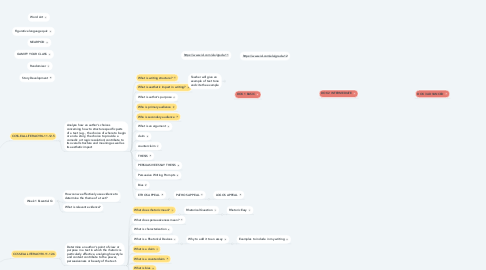
1. Tone vs. Mood
2. CCSS.ELA-LITERACY.RL.11-12.1
2.1. Cite strong and thorough textual evidence to support analysis of what the text says explicitly as well as inferences drawn from the text, including determining where the text leaves matters uncertain
2.1.1. What does it mean to cite?
2.1.1.1. mla essay in text citation
2.1.1.1.1. MLA citation works cited example
2.1.2. What does thorough mean?
2.1.3. what does textual evidence mean?
2.1.4. What does support mean?
2.1.5. What does analysis mean?
2.1.6. what does explicitly mean?
2.1.7. What does inference mean?
2.1.8. What does uncertain mean?
3. CCSS.ELA-LITERACY.RL.11-12.2
3.1. Determine two or more themes or central ideas of a text and analyze their development over the course of the text, including how they interact and build on one another to produce a complex account; provide an objective summary of the text.
3.1.1. What is central idea or theme?
3.1.2. What is writing development?
3.1.2.1. Also
3.1.3. What is account in writing?
3.1.4. What does objective mean?
3.1.5. What is a writing summary?
4. CCSS.ELA-LITERACY.RL.11-12.4
4.1. Determine the meaning of words and phrases as they are used in the text, including figurative and connotative meanings; analyze the impact of specific word choices on meaning and tone, including words with multiple meanings or language that is particularly fresh, engaging, or beautiful. (Include Shakespeare as well as other authors.)
4.1.1. What does figurative mean?
4.1.1.1. Figurative types
4.1.1.1.1. Figurative poem
4.1.2. What does connotative mean?
4.1.3. What is writing tone?
4.1.4. What are tone and mood video
5. CCSS.ELA-LITERACY.RL.11-12.5
5.1. Analyze how an author's choices concerning how to structure specific parts of a text (e.g., the choice of where to begin or end a story, the choice to provide a comedic or tragic resolution) contribute to its overall structure and meaning as well as its aesthetic impact
5.1.1. What is writing structure?
5.1.2. What is aesthetic impact in writing?
5.1.3. What is author's purpose
5.1.4. Who is primary audience
5.1.5. Who is secondary audience
5.1.6. What is an argument
5.1.7. claim
5.1.8. counterclaim
5.1.9. THESIS
5.1.10. PERSUASIVE ESSAY THESIS
5.1.11. Persuasive Writing Prompts
5.1.12. Bias
5.1.13. ETHOS APPEAL
5.1.13.1. PATHOS APPEAL
5.1.13.1.1. LOGOS APPEAL
6. CCSS.ELA-LITERACY.RL.11-12.3
6.1. Analyze the impact of the author's choices regarding how to develop and relate elements of a story or drama (e.g., where a story is set, how the action is ordered, how the characters are introduced and developed).
6.1.1. How to Develop a Story - 10 Steps to Better Plots | Now Novel
6.1.2. expository
6.1.2.1. audio
6.1.2.2. visual
6.1.2.3. written
6.1.3. descriptive
6.1.3.1. audio
6.1.3.2. visual
6.1.3.3. written
6.1.4. narrative
6.1.4.1. audio
6.1.4.2. visual
6.1.4.3. written
6.1.5. persuasive
7. DOK 1 BASIC
8. DOK 2 INTERMEDIATE
9. DOK 3 ADVANCED
10. DOK 4 MASTERY
11. The Story of the Three Apples pages 1-2
12. Teacher will give an example of text tone and cite the example
12.1. Student will give the text tone and cite the example
12.1.1. Teacher will give inference example
12.1.1.1. Student will give inference example
12.1.1.1.1. Teacher will critique example
13. The Story of the Three Apples pages 3-4
14. CCSS.ELA-LITERACY.RI.11-12.6
14.1. Determine an author's point of view or purpose in a text in which the rhetoric is particularly effective, analyzing how style and content contribute to the power, persuasiveness or beauty of the text.
14.1.1. What does rhetoric mean?
14.1.1.1. Rhetorical Question
14.1.1.1.1. Rhetoric Easy
14.1.2. What does persuasiveness mean?
14.1.3. What is characterization
14.1.4. What is a Rhetorical Devices
14.1.4.1. Why to add it to an essay
14.1.4.1.1. Examples to include in my writing
14.1.5. What is a claim
14.1.6. What is a counterclaim
14.1.7. What is bias
14.1.8. LOGIC APPEAL
14.1.8.1. ETHOS APPEAL
14.1.8.2. PATHOS APPEAL
14.1.8.3. LOGOS APPEAL
15. Week 1
16. Week 1 Essential Q
16.1. How can we effectively use evidence to determine the theme of a text?
16.2. What is relevant evidence?
17. Week 2 Essential Q
17.1. How does bias affect our writing?
17.2. Why is literature similar to real life?
18. CCSS.ELA-LITERACY.RI.11-12.1
18.1. Cite strong and thorough textual evidence to support analysis of what the text says explicitly as well as inferences drawn from the text, including determining where the text leaves matters uncertain.
18.1.1. What does implied mean
19. CCSS.ELA-LITERACY.RI.11-12.2
19.1. Determine two or more central ideas of a text and analyze their development over the course of the text, including how they interact and build on one another to provide a complex analysis; provide an objective summary of the text.
20. https://www.ixl.com/ela/grade-11
21. CCSS.ELA-LITERACY.L.11-12.1
21.1. Demonstrate command of the conventions of standard English grammar and usage when writing or speaking
22. CCSS.ELA-LITERACY.L.11-12.3
22.1. Apply knowledge of language to understand how language functions in different contexts, to make effective choices for meaning or style, and to comprehend more fully when reading or listening.
22.1.1. Making effective word choices for meaning and style
23. CCSS.ELA-LITERACY.L.11-12.1.A
23.1. Apply the understanding that usage is a matter of convention, can change over time, and is sometimes contested
23.1.1. Convention word usage
23.1.2. Word usage over time
23.1.3. Contested word usage
23.1.4. What does convention mean
23.1.5. What does contested mean
24. CCSS.ELA-LITERACY.L.11-12.3.A
24.1. Vary syntax for effect, consulting references (e.g., Tufte's Artful Sentences) for guidance as needed; apply an understanding of syntax to the study of complex texts when reading.
24.1.1. What does syntax mean
24.1.2. What is consulting references for guidance
24.1.3. What does complex text look like

